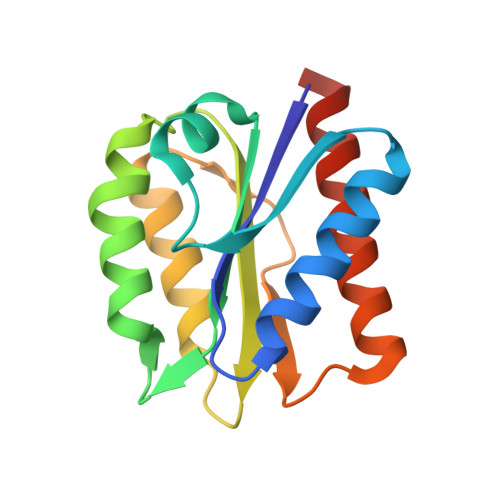Structure and function of an unusual flavodoxin from the domainArchaea.
Prakash, D., Iyer, P.R., Suharti, S., Walters, K.A., Santiago-Martinez, M.G., Golbeck, J.H., Murakami, K.S., Ferry, J.G.(2019) Proc Natl Acad Sci U S A 116: 25917-25922
- PubMed: 31801875
- DOI: https://doi.org/10.1073/pnas.1908578116
- Primary Citation of Related Structures:
5WID - PubMed Abstract:
Flavodoxins, electron transfer proteins essential for diverse metabolisms in microbes from the domain Bacteria , are extensively characterized. Remarkably, although genomic annotations of flavodoxins are widespread in microbes from the domain Archaea , none have been isolated and characterized. Herein is described the structural, biochemical, and physiological characterization of an unusual flavodoxin (FldA) from Methanosarcina acetivorans , an acetate-utilizing methane-producing microbe of the domain Archaea In contrast to all flavodoxins, FldA is homodimeric, markedly less acidic, and stabilizes an anionic semiquinone. The crystal structure reveals an flavin mononucleotide (FMN) binding site unique from all other flavodoxins that provides a rationale for stabilization of the anionic semiquinone and a remarkably low reduction potentials for both the oxidized/semiquinone (-301 mV) and semiquinone/hydroquinone couples (-464 mV). FldA is up-regulated in acetate-grown versus methanol-grown cells and shown here to substitute for ferredoxin in mediating the transfer of low potential electrons from the carbonyl of acetate to the membrane-bound electron transport chain that generates ion gradients driving ATP synthesis. FldA offers potential advantages over ferredoxin by ( i ) sparing iron for abundant iron-sulfur proteins essential for acetotrophic growth and ( ii ) resilience to oxidative damage.
- Department of Biochemistry and Molecular Biology, The Pennsylvania State University, University Park, PA 16802.
Organizational Affiliation:



















